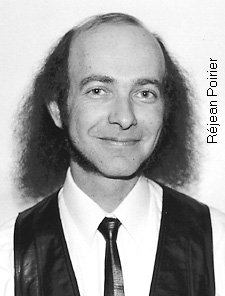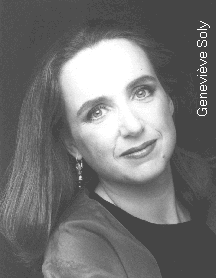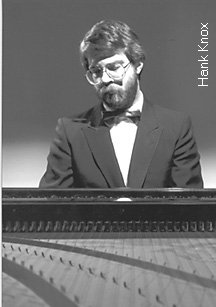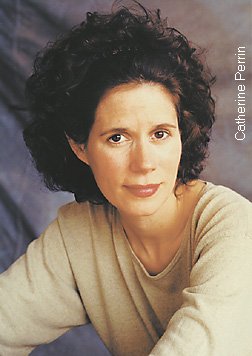Taming the Harpsichord by Alain Bénard
/ June 1, 1999
Version française...
Authoritative yet inspired, today's
harpsichordists are masters of their instruments as never before. The resurgence of
interest in period music has led to a rediscovery of the spirit of baroque compositions
and the harpsichord's subtle resonance. Audiences are drawn to this instrument in growing
numbers, while established fans are intrigued by its expanding repertoire.
In anticipation of the forthcoming
harpsichord festival (les Journées du clavecin) and the Montreal International
Harpsichord Competition, featuring French composers and scheduled for June 3 to 6 at the
Salle Pierre-Mercure in the Pierre-Péladeau Centre, we talked to four experts in the art
of the harpsichord -- Catherine Perrin, Geneviève Soly, Hank Knox, and Réjean Poirier.
Renaissance
 The harpsichord owes its current renaissance to
the rise of interpretative schools in the recent past. These have had a significant effect
on both the building and playing of the instrument. It was after musicians began using
period instruments (or modern reproductions) that things began to develop, says
harpsichordist and organist Réjean Poirier, dean of the Faculty of Music at the
Université de Montréal. The harpsichord owes its current renaissance to
the rise of interpretative schools in the recent past. These have had a significant effect
on both the building and playing of the instrument. It was after musicians began using
period instruments (or modern reproductions) that things began to develop, says
harpsichordist and organist Réjean Poirier, dean of the Faculty of Music at the
Université de Montréal.
"Until the early 1960s, the
harpsichord revival focused on Wanda Landowska's approach to the instrument. Musicians
looked at the instrument from a modern standpoint, however. They didn't play old
instruments, and the repertoire was still being rediscovered. The importance of the
instrument -- the need to find a good instrument -- was not considered. Generally
speaking, people were doing a great deal of research to try to recapture the spirit of
baroque music, but the return to period instruments was just beginning."
Geneviève Soly, the festival's artistic
director, hopes today's audiences will free themselves from any preconceived notions or
outmoded ideas that might hamper the harpsichord's growing popularity. "Often people
don't like the harpsichord because it's unfamiliar, or because they remember how it
sounded twenty years ago," she points out. "Today's instruments are infinitely
better; there have been enormous improvements in production, and the same can be said of
performers and styles of performance."
Capturing the spirit
The harpsichord is a very demanding
instrument. Those who play it must feel really drawn to the repertoire and be willing to
understand the various outlooks and cultures that influenced its use during its heyday in
the seventeenth and eighteenth centuries, Soly feels.
 "You need a really attentive ear that is
open to everything new. To play the distinct baroque repertoires, you virtually have to
learn a new artistic language for each, since they vary from country to country. In
addition, you must have the technique to handle all the intricacies of touch and sound.
The harpsichord is naturally a rather dry-sounding instrument. There's no mechanism for
sustaining sound; the musician's fingers have to do it all. That's why you have to keep
listening to what you're playing, constantly adapting to get the sound you want. The
harpsichordist is very involved with creation -- or re-creation -- because the playing of
distinct repertoires requires a very sensitive approach. I don't see how anyone can
interpret baroque music without an extensive musical and historical background." "You need a really attentive ear that is
open to everything new. To play the distinct baroque repertoires, you virtually have to
learn a new artistic language for each, since they vary from country to country. In
addition, you must have the technique to handle all the intricacies of touch and sound.
The harpsichord is naturally a rather dry-sounding instrument. There's no mechanism for
sustaining sound; the musician's fingers have to do it all. That's why you have to keep
listening to what you're playing, constantly adapting to get the sound you want. The
harpsichordist is very involved with creation -- or re-creation -- because the playing of
distinct repertoires requires a very sensitive approach. I don't see how anyone can
interpret baroque music without an extensive musical and historical background."
Poirier asserts that university training is
indispensable because researching manuscripts, which is a task for a musicologist, is part
of the harpsichordist's job. And even though teaching on this side of the Atlantic is more
than adequate nowadays, contact with Europe is still necessary to enrich the musician's
artistic scope.
Taking chances
 A creative harpsichordist must like taking
chances. A thorough theoretical basis is necessary, particularly a knowledge of the
figured bass, but the musician also has to combine this with a certain amount of freedom,
perhaps akin to jazz improvisation. "Nothing remains theoretical," says Hank
Knox, McGill music professor and harpsichordist for the Arion Ensemble. "You've got
to have everything literally at your fingertips. The practical aspect is what first
fascinated me. Then I discovered that you must improvise your own part. It was an
exhilarating moment, and I've never looked back since. We have enormous freedom. It
inspires you to try the unknown, to take chances." A creative harpsichordist must like taking
chances. A thorough theoretical basis is necessary, particularly a knowledge of the
figured bass, but the musician also has to combine this with a certain amount of freedom,
perhaps akin to jazz improvisation. "Nothing remains theoretical," says Hank
Knox, McGill music professor and harpsichordist for the Arion Ensemble. "You've got
to have everything literally at your fingertips. The practical aspect is what first
fascinated me. Then I discovered that you must improvise your own part. It was an
exhilarating moment, and I've never looked back since. We have enormous freedom. It
inspires you to try the unknown, to take chances."
Some interpreters have very strong views
about baroque style and interpretation. It's possible to differ about various practices in
ensemble playing -- the harpsichord being the point of contact for these diverse
approaches.
"I have a lot of respect for what was
done in England about ten years ago, but that doesn't prevent my finding this approach
very cold now. Perhaps someone like Fabio Biondi takes a really exaggerated approach, but
I admire his spirit of improvisation and his willingness to explore the music," says
Knox.
A question of language
For harpsichordist Catherine Perrin of I
Musici de Montréal (she has just completed a fine solo CD for ATMA), the vast repertoire
is one of the instrument's great attractions. Early on in her career she developed a
sensitivity for the French repertoire, which had been largely forgotten. She worked at
acquiring an intimate understanding of harpsichord music and its "language." As
she says, "The language and literature of the harpsichord were natural to me. The
phrasing and ornamentation were as intuitive as thinking and speaking."
 The language of the harpsichord is
highly classical, of course, but it has the capacity to move into other musical eras.
Perrin is interested in contemporary music and has no problem with combining the old and
the new. The language of the harpsichord is
highly classical, of course, but it has the capacity to move into other musical eras.
Perrin is interested in contemporary music and has no problem with combining the old and
the new.
"It's my ambition to make two worlds
co-exist," she says. "I choose expressive, exceptional pieces that are perfectly
suited for the harpsichord. They're not conservative, but their roots are in this type of
instrument. I tend to play music that doesn't just use the harpsichord as a way of
producing sound; the music is a means of developing the language of the instrument, making
it sound generous, the way it should."
Acoustically speaking, aside from tuning
the instrument to appropriate temperaments and mastering a recalcitrant plectrum, the
success of a harpsichord recital depends largely on where it is played, according to
Réjean Poirier. One of the main errors in the early days of the baroque revival, he
feels, was that concerts were given in unsuitable venues. Appropriate settings such as a
chateau, a small church, or a modern hall like the Salle Pierre-Mercure affect the music
and enable it to capture the listener's attention. The challenge to musicians is to
develop a sensitive ear, and to make themselves heard not through the volume produced but
through the subtle intricacies of the instrument -- a distinction that exemplifies what
the harpsichord is all about.
Version française... | 

